Han Terra
| Han TeRra 한테라 | |
|---|---|
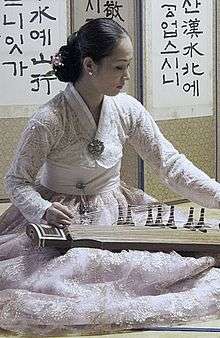 Han plays Kayageum at the Korean Cultural Council of Embassy in Tokyo, Japan, 2010 | |
| Background information | |
| Born |
March 30, 1981 Seoul, South Korea |
| Genres | Classical |
| Occupation(s) | Kayageum player, singer, dancer |
| Instruments | Kayageum |
| Years active | 1989–present |
| Labels | Poly Music Co., Poly Classics |
| Website | terrahan.com |
| Notable instruments | |
|
Korean kayageum Korean National Major Cultural Treasure No. 42 | |
| Korean name | |
| Hangul | 한테라 |
| Hanja | 韓泰來 |
| Revised Romanization | Han Tera |
| McCune–Reischauer | Han T'era |
Han TeRra (한테라, born March 30, 1981) is a South Korean kayageum virtuoso, singer and dancer. She was a child prodigy and was performing by age 8. She began her training at the age of 4 in Western classical music and Asian traditional performing arts including singing and dancing in Korea, Japan and China. She has been performing all over the countries such as South Korea, Japan, China, the United States and France.
Han is the first recipient of kayageum virtuoso of Blanchette Rockefeller Fund, Asian Cultural Council, and the youngest Korean traditional musician who had a debut in the Carnegie Hall, New York City in the United States. In 2016, she was admitted voting member of the Grammy Awards of the National Academy of Recording Arts and Sciences in United States as few Asian musicians.
Name and genealogy
In South Korea, originally she was named Raesook (래숙, 來俶: "Advent of Goodness" or "Goddess") and got a Buddhist name Meongwol (명월, 明月), which means 'bright moon' at her early teen age from her Buddhist priest. Han has another ho Danyoung (단영, 澶濴) either. She created the name of 'TeRra' by herself based on the ideas of Latin languages and the earth goddess Tellus and combined all the conception of her other names in the 2000s.
Han is a Cheongju Han (청주 한씨, 淸州 韓氏) clan, the clan is well known for producing most 6 queens in the Choseon Kingdom. On her mother side, grandmother's family was a immigrant from Japan to Korea in the late 1920's accumulated wealth by fashion and textile business.
Early life
Western classical music studies
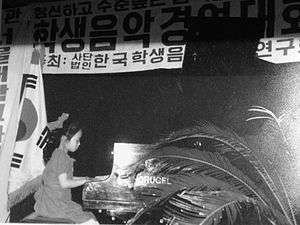
Terra was born in Seoul, South Korea. Her initial ambition was to become a pianist,[1] having taken piano lessons at the age of 4. As soon as she started piano, she amazed her neighbors that she mastered Czerny's piano etude, Mozart Sonata's, Bach's pieces so quickly. Soon she was awarded a special prize in the Korean National Piano Concours at age of 8.[2] She also played piano for her school's choir, in addition to the piano, she studied various western musical instruments such as violin, flute. When she was age at 8, she composed a song first and it was published on her elementary school's annual journal.
She said 'I am still admiring piano's artistry more than my kayageum's pretty often. I did play piano intrigued by its melodic beauty and the clear techniques from the artwork as instrumental itself, yet I have been doing kayageum for fun. It perpetually stimulates my curiosity, it was eventually questions of our mysterious world.' in the interview with Seoul Shinmun.[3]
Korean traditional music
Spurred by her mother's encouragement, however, she began to study Korean classical music focused on Kayageum and dance at the age of six. When she was eight, she was awarded the Grand special prize as the youngest recipient in the Korean National Student Music Competition in 1989.[2]
During her early years, Han had mastery of full version of kayageum Sanjo of Seong Kuem Yeon, Kim Juk Pa, Choi Ok Sam school and all repertoires of kayageum court music, Jeong-ak. She also extended her mastery of the instrument such as the 18, 21 and 25 stringed kayageums during the 1990s. her technique and refined sound of her playing were legendary, while in the Gugak National Middle school and Gukak National High school, her practice at the school attracted many colleagues who came to observe her playing. Her colleagues used a nickname of 'CD(compact disc) album', a reference to her sound she created that reflects old kayageum master's recordings. It was also an affectionate joke referring to her small and elegant facial physique, which is about a full CD size.[1]
Musical crisis
After the period of intensive training in Kayageum during her early, precocious years, Han went through a period of crisis, which brought confusion of musical identities and mannerisms, as her adolescent years were coming to a close. Han graduated from Gugak National Middle and High School (the premier National Korean Music school for teens). However, because she had masted already almost solo kayageum solo pieces that she had a hard time to adjust to school's life and their curriculums.[4] Despite she didn't want to enter a college to focus herself to music, Han graduated from the High School as the top of music classes and entered the department of Korean classical music, Seoul National University,[5][6] with the blessings of the high school's principal as the first-recommended .
During this period, she briefly considered quitting music altogether and instead pursuing a career in journalism.[7]
When she was a college student at Seoul National University, she was a reporter at the SNU Journal.[8] As well as, she was a heroine actress for an independent film directed which was entered in a film festival in 2002.
TeRra, book by The Korea Times
2015, Han resumed official her activity after period of for 11years with an ebook 'TeRra' written by the Jang Byung Wook who is a columnist in South Korea it published by The Korea Times. Coincidentally live album 'TeRra (Live)' released which is containing her performance for 15 years.
Education
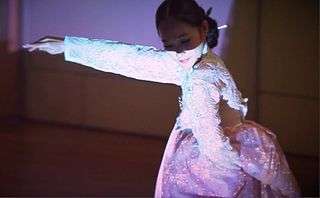
Han graduated from Gugak National Middle and High School (the premier National Korean Music school for teens) and entered the department of Korean classical music, Seoul National University,[5] College of Music,[6] with the blessings of the high school's principal as the first-recommended . After graduation from Seoul National University in 2004, she continued her postgraduate studies at the same university. Han holds a master's degree in music and is currently completing the requirements for the D.M.A degree in Kayageum performance from Seoul National University.[9]
Han trained on the kayageum[2] under the Kim IlRyun[10] since her early years, studied under the professor Chae-suk Lee,[11][12][13] and studied Kayageum Jeong-ak for Korean court music under the Jeongja Kim[14] at the Seoul National University. Han also studied Pansori and Kayageum Byeongchang under Yoojin Chung,[15] as well as, was trained Korean classical dance such as Salpuri, Buchaechum, Chunaeg-Jeon and so on by Eunhee Song.
Han speaks 5 languages: Korean, Japanese, Chinese, English and French.[7]
Asian performing arts (Japan, China, India et.c)
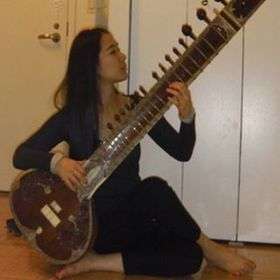
Han was trained other Asian zither traditions including the Japanese Koto, Shamisen, the Chinese Guzheng, and the Indian Sitar. Through her research stints in Japan and China, Han acquired deeper understanding of the pan-Asian musical heritage. She took lessons of Japanese Koto of Ikuta school under the professor Ando Masateru at Tokyo University of the Arts and Chinese Guzheng, North Korea and Yanbian province Kayageum under the Chinese National Human Heritage, Xingsan Jin at the Yanbian University and studied their traditional other performing arts forms such as Japanese traditional dance and singing. In addition, she studied Indian Sitar with Daisy Paradis in New York.[16]
Presently, she is a member of Asian Musicology.[17]
Career
Collaborations
Active as a concert soloist since age 12, Han collaborated with many Korean traditional music Orchestra such as Seoul Metropolitan Korean Music Orchestra, National Orchestra of Korea, Jeonju Korean Music Orchestra, Daejeon Korean Music Orchestra with representative conductors of Korean music such as Jaewon Lim,[18] Pyeonryong Lim,[19] Sangil Han. Pyeongryong Lim hailed her as one of the most talented Kayageum players. In addition, she was chosen a soloist at the subscription concert of Seoul National University, College of music in 2002, she played kayageum concerto 'Saeya Saeya' composed by Sungcheon Lee[20] with the Korean Music Orchestra of Seoul National University conducted Chulho Kim,[21] who was an executive director of National Gugak Center.[2] at the Yeak-dang of National Gugak Center, 2002.
Recitals
Han had solo recitals at the Sejong Center sponsored by Seoul City, Kumho Art hall[22] sponsored by Kumho Asiana Cultural Foundation, Youngsan Art Hall,[23] among other musical venues of Korea. She cemented her reputation as the young prodigy of kayageum when she was selected as the first Kayageum player in the Young Artist by Kumho Cultural Foundation in 1999. Subsequently, she performed the Kayageum Jeong-ak(Korean court music), Kayageum Sanjo, Spring Snow for 18 stringed kayageum composed by Hwang Byungki, Bell flower variations for 25 stringed kayageum at her recital in 2000 since she played all kinds of kayageum such as traditional 12 stringed and 18,25 stringed kayageum.
In 2009. Han had an invited recital[24] at the Namsan Traditional Theater, she was acclaimed as she met the challenge of keeping the balance between the original Korean music tradition and the newly emerging world music. She also played the 'Five scenes for Kayageum' composed by the prominent composer of modern classical music, Sukhi Kang with the 21 stringed kayageum. The piece had been played with a 25 stringed kayageum because of the complexity of the composition. The performance garnered acclaim and endorsement from the composer for her musical audacity and the extraordinary techniques she commanded.[25][26]
Chamber music and orchestra
Han was a charter Kayageum player of the Korean Traditional Music Youth Orchestra in 2003, after graduated Seoul National University, became the youngest Kayageum player of the Seongnam Municipal Korean Classical Music Orchestra.[27] Presently, she is a member of the Korean Zither's Association.
Compositions
TeRra Han started release of her own compositions since 2016, but she was already arranging piano pieces to kayageum when she was early child ages such as by Mozart, Bach. She mentioned that she had never been educated composing, learned by herself, as well as, she was influenced by Sukhi Kang, Pierre Boulez and John Zorn. In the interview with on SBS TV Show Culture Club, she said she had never wanted to compose music but it was devotion.[28]
Her first composition is 'Viola Code No. 1', it was inspired by the French poet Charles Baudelaire & Korean Sanghwa Lee, it was world premiered by French violist Erwan Richard on her recital celebrating 130th anniversary of diplomatic relations between France and Korea. The second composition is 'Piano Code No. 1' inspired by arts work 'Wind of the Ancient Times' (2010, terra cotta) by Insu Choi, the piece was worked premiered by herself with kayageum arranged gallery art link 2016.[29]
However Ms. Han's original beginning composition was happened at age of 8, it was published on her elementary school's annual journal. [30]
International debut
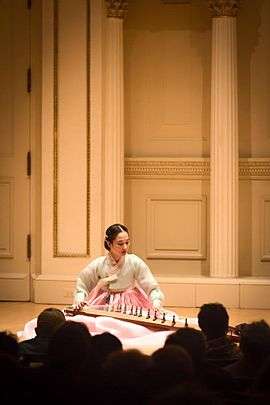
United States
Han debuted internationally through series of recitals in the United States at venues such as Sam Sumg Hall of the Asian Art Museum of San Francisco as part of the San Francisco International Arts Festival,[31][32] and the Doris Duke Hall at the Honolulu Academy of Arts, and the Northwest Folk life Festival in Seattle. She was billed as the 'latest young prodigy of kayageum'.[2][33][34][35] although she had performed all over the countries in the world until then.[2] even though she had extensively performed both in and outside Korea by then. Her US concerts includes an invited recital at Brown University in 2008 in which she performed kayageum Sanjo, Byeongchang (singing with kayageum), Korean traditional dance and contemporary music using the 25-string kayageum.
Since 2010, she widened her musical presence in New York City where she began collaborations with various experimental, improvisational and other avant-garde groups, exchanging musical heritage with a variety of artists, especially in minimalism and improvisational style of music as represented by eminent composers Philip Glass, Steve Reich and John Zorn.[36]
Carnegie Hall debut
On September 29, 2015, Han had debut stage at the Weill Recital Hall, Carnegie Hall, in New York.[37][38][39] It was actually internationally tour concert starting from at the Suginami Public Hall in Tokyo, Japan[40][41] and National Gugak Center in Seoul, South Korea.[42] She played Kayageum Sanjo full version of Choi Ok Sam which is a National intangible heritage No.23 of South Korea,[41] it was world premier that Choi Ok Sam sanjo full version performed and she was the youngest Korean traditional musicians of a few who ever had a recital at the Carnegie hall, even at the Suginami Public Hall, either.[41]
Asia
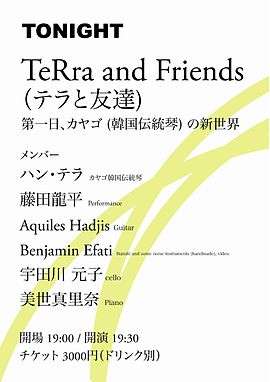
In 2010, Han resided for some time in Tokyo, Japan during which she tried to adapt Japanese traditional music for Kayageum such as Haru no Umi, Ochibanoodori of Miyagi Michio through collaborations with Japanese traditional instrumentalist. The effort was supported by the Korean Cultural Council of Korean Embassy in Japan.[43]
Han visited Yanbian in Northeast China in 2011 to research performing arts forms of North Korea, Yanbian province and China with the Xingsan Kim who is a Chinese National Heritage of Kayageum of China. Their collaboration included exchange of musical concepts and playing techniques of 21,22 and 23 stringed kayageums.[44]
French Arts Relations (RÉVÉLATION )
TeRra Han had stayed in Paris 2012, since then she has been collaborating with French artists such as visual artist Benjamin Efratit, electronic musician Richard Pinhas. In 2016, celebrating 130 years of diplomatic relations of France and Korea, she had a recital, REVELATION series at the Sejong Center for the Performing Arts in Seoul supported by the Institut Français.[45] For this recital, Terra Han revisits the music at Kagayeum and has a France-Korean version of this traditional instrument, with the participation of Erwan Richard, French violist. Through the solos and duets of the artist and one can see the genius of Baudelaire, the Korean court music of the 11th century, but also the French and modern classical music.[46][46]
She arranged and performed by herself "Le cygne" by Saint-Saëns, and works by Marin Marais, Claude Achille Debussy, Carl Maria von Weber, etc. and her own composition "MA DoNNA" inspired by the French poet Charles Baudelaire and Korean Sanghwa Lee.[47]
"Moving Work of Art"
During her stay in New York City in 2012, she presented the music and dances in the tradition of Chosun Kisaeng (Courtesans of the Chosun Dynasty), titled "Sonnet of an Innocent Flower"[48] at the Korea Society.[49] During the performance, the prominent authority on the Korean music, Dr. Robert. C Provine accompanied her performance with a segments of lectures on each piece. After the event which encompassed kayageum music, song and dance which faithfully replicated the fabled Chosun Kisaeng tradition, people who attended the event hailed her as a "Moving Work of Art".[50][51][52][53]
The TeRras
She visited Tokyo again in 2012 for the purpose of furthering exchange and development of Asian Arts through collaborations with various Japanese artists. The effort culminated in a series of recitals, "Han TeRra Korean Kayago Relay Recitals Tokyo" for five days. The collaborators included Aquiles Hadjis, video artist Benjamin Efrati, pianist Marina Mise, flutist Yoshiki Nose, koto player Hukuda Yasuko, Fujita Ryuhei and so on. Gallery Fuuro, Gallery Pam-a, Mejiro Garden, Supper Deluxe supported the recitals and the Korean Cultural Council of Korean Embassy in Japan sponsored. Her fan club, the TeRras, Han TeRra Kayago Society, was founded in Tokyo during the concert.
A Maestro who Saved Girl Genius (RÉVÉLATION)
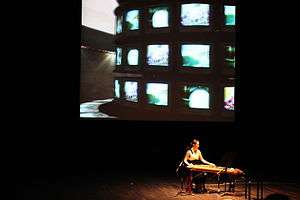
She had contribution concerts for 80 years birth of Sukhi Kang who is one of the most representative contemporary composers of South Korea hosted by Museum of Modern and Contemporary Arts of Republic of Korea, Seoul Museum of Arts and Museum of Arts, Seoul National University 2015 April–May.[54][55][56] The concert of the Museum of Modern and Contemporary Arts was appointed the official cultural event by Korean government. In fact, the concert series of hers which happened as long as 11 years in Korea since she spend time in overseas including Tokyo, New York, Paris and Beijing, as well as the long period of identical crisis of music by herself.[57]
She presented cutting-edged contemporary masterpiece of Sukhi Kang's which she arranged the pieces for western classical ensemble instruments to solo kayageum as a world premiere, either. One of the pieces was an improvisational electronic kayageum music with film of Namjun Paik who was a visual artist, close friend to Sukhi Kang.[55]
She made headlines titled 'A Maestro who Saved Girl Genius Lost Curiosity, Sukhi Kang and TeRra Han' printed by The Korea Times, written by Byung Wook Jang who is one of the most prominent journalist in South Korea, March 24, 2014.[54]
After her concerts, the journalist Jang Byung Wook wrote a book about Han as form of ebook titled Terra, it was printed by The Korea Times DB contents department, Feb. 2015.[30][58][59]
Scientific research on acoustics of Asian zithers
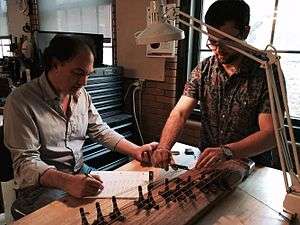
She tried scientific approach to acoustics of Asian string instrument. Since 2011, she has been visiting to the acoustics department of the Massachusetts Institute of Technology and North Bennet School in a scientific approach to relationship between arts and science[60][61] She presented 'Introduction to the Asian Zither through the 12 stringed Korean kayageum' at the room 3-207 MIT 2012.
Fashion collection
TeRra Han has been designing her dress for performance at the stage until now, she had a first fashion collection and show in Tokyo, gallery Pam-a 2013. She designed the show with her own kayageum music, about 10 models had a show at the stage. The title was 'from chima-chogori to court dress of Choseon', as reported by Tokyo Times (Tokyo Shimbun).[62]
Media appearance
In 1999–2000, Han has appeared in several TV programs of Korean Broadcasting System for giving new message celebrating new millennium years 2000. In addition, she appeared in some entertainment programs of Korean Broadcasting System, Seoul Broadcasting System and traditional music programs. Also she had interviews music radio, Gugak FM.
TeRra Han made headlines and full cover of major newspapers such as the Korea Daily, The Korea Times, Epoch Times, etc., and The Korea Times published a book of her, TeRra written by Byungwook Jang, Korean prominent columnist 2015.[63]
Epoch Times made cover page with her performance at the Carnegie Hall and the article of her music pressed as titled "The essence of the Korean traditional music in 21 century"[64] written by the publisher Stephen Gregory, and columnist Milene Ferendaz epoch times Oct.30th both online and paper version. Milene Ferendaz described her 'work of art of ancient times that had come to life.'[64] The journalist, Gomiyoji (五味 洋治) reported her as a title 'Bridging Asian in Music' in the Tokyo Shimbun, 17 October. In addition, The Korea Times reported her as 'Best Korean kayageum musician have a Carnegie Hall debut as the youngest kayageum musician'.[65]
Discography
Han's albums include recordings of traditional kayageum solo music, concertos and variety of chamber music including court music, sanjo music and contemporary music. She has also recorded in non Korean kayageum music styles, in Japanese and Chinese traditional music with Koto or Guzheng.[66][67] Her Japanese Koto album 'Sakura' was appointed as the special edition celebrating for the 50years of the diplomatic relations between Korea and Japan by the governments.
Awards and recognition
- 1989. Korea National Students Musical Competition Special Grand Prize, Piano
- 1989. Korea Music Society, National Musical Competition Special Grand Prize, Kayago
- 1992. Korean Student Musical Competition, Gold Prize
- 1994. Winner of Official Commendation of Korean UNESCO
- 1999. Dong-A Daily, Korean Musical Competition, Silver Prize
- 2001. Han-bat National Kayago Contest Grand Prize
- 2004. Chung-ju National Kayago Contest Gold Prize
- 2009. Sejong Center, Sejong Korean Musical Competition 2nd Prize
- 2010. The First Recipient of Kayageum player, Blanchette Rockefeller Fund, Asian Cultural Council in the United States
Schools
- 2000. Korean National Traditional Music Middle and High school
- 2004. Seoul National University, College of Music (B.A)
- 2006. Seoul National University, College of Music (M.A)
- 2010. Special Doctoral Researcher of the Tokyo University of the Arts, Tokyo in Japan
- 2011. Special Doctoral Researcher of the Yanbian University, Yanji in China
- 2014. Exchanging Visiting Fellows, China Central Conservatory of Music, Beijing in China
- –2005. Complete the Senior Course of Korean Traditional Dance, National Center for Korean Traditional Performing Arts
- –2010. Complete Japanese Traditional Music Program, Tokyo University of the Arts, Tokyo in Japan
Others
- 2002–2003. Korean National Traditional Music Youth Orchestra, charter member
- 2005–2009. Seong-Nam City Korean Traditional Music Orchestra, charter member
- 2005–Present. Korean Zither's Association, the youngest member
- 2010. Lecturer of Korean Music at Korean Embassy in Tokyo, Japan
- 2011–Present. Asian Musicology, member
- 2010 Honorary Ambassador of Korean Center for International Affairs, Academy of Korean Studies
- 2016 Voting Member of the Grammy Awards of the NARAS (National Academy of Recording Arts and Sciences) in United States
Thesis
2006. An analytical studies on composition of 5 scenes for Gayageum by Sukhi Kang
Publications
- 2015 TeRra: eBook written by Byung-Wook Jang (published by The Korea Times)
References
- 1 2 "가야금 연주자 한테라". Korean Times, New York.
- 1 2 3 4 5 6 "San Francisco International Arts Festival".
- ↑ ""나만의 성음으로 우리 음악 아름다움 알리고 싶어"". 서울신문. Retrieved 2016-10-06.
- ↑ "Gayageum virtuoso TeRra Han". KBS World Radio. 2016-04-26.
- 1 2 The Korea Society, 17th. Jan.2013
- 1 2 "서울대학교 | 서울대학교 음악대학". music.snu.ac.kr. Retrieved 2016-10-03.
- 1 2 Conversation after the performance at the Korea Society, Jan.2013
- ↑ "네이버 책". book.naver.com. Retrieved 2016-02-22.
- ↑ "Sonnet of an Innocent Flower, the Korea Society, New York".
- ↑ Kim Il Ryun, Professor of Chungang University, Korea
- ↑ 가야금 대모, 이재숙 서울대교수, 서울신문, 2006.7.28
- ↑ 이재숙, 문화포털 예술지식백과
- ↑ Char-suk Lee, Kayageum Sanjo
- ↑ Echoes to Heaven, Cnl music, 5.14.2003
- ↑ Fan page, Han TeRra Kayago Society, Tokyo,
- ↑ Evening of Korean Kayago by Han TeRra, Asian Cultural Council, New York, 29 March 2012
- ↑ Asian Musicology, Korea
- ↑ "대전연정시립문화회관 상임지휘자내정, 임재원 교수". Yeonhap News.
- ↑ "세계속에 국악을 외치다, 임평룡지휘자". Sports Today, Korea.
- ↑ 이성천, 고죽지절의 선비작곡가
- ↑ 김철호 국립국악원장, 국악기 표준음고 발표, 파이낸셜 뉴스
- ↑ Kumho Young Artist Concert, 27th.April. 2000.
- ↑ Youngsan Art Hall
- ↑ "Han TeRra kayageum recital, Traditional Music Theater, Seoul, 2009".
- ↑ "Han TeRra Kayageum Recital". 경향신문.
- ↑ "설중사우의 향연, 한래숙 가야금 독주회, 남산국악당". 국악신문.
- ↑ 성남시립예술단, Seongnam Arts Center, South Korea
- ↑ http://program.sbs.co.kr/builder/programMainList.do?pgm_id=00000347380
- ↑ http://www.edaily.co.kr/news/NewsRead.edy?SCD=JI51&newsid=01771206612621040&DCD=A405&OutLnkChk=Y
- 1 2 "네이버 책". book.naver.com. Retrieved 2015-10-20.
- ↑ sfiaf. "San Francisco International Arts Festival".
- ↑ Han TeRra's International Debut, May, 2008
- ↑ "Kayageum Performance at the Doris Duke Hall, May 2008".
- ↑ "국악의 세계화과 과제.". Korean Times.
- ↑ "마음에 와닿는 우아한 음악".
- ↑ "the Stone, December 31, 2011".
- ↑ "TeRra Han, Kayageum". www.carnegiehall.org. Retrieved 2015-10-20.
- ↑ 무단전재, Ⓒ 종합 경제정보 미디어 이데일리-상업적; 금지, 재배포. "한테라, 뉴욕 카네기홀서 `가야금 산조` 연주". edaily. Retrieved 2015-10-20.
- ↑ "가야금 연주자 한테라, 뉴욕 카네기홀서 공연 - 화이트페이퍼". www.whitepaper.co.kr. Retrieved 2015-10-20.
- ↑ "가야금 연주자 한테라, 동경 스기나미 공회당 공연 성황리에 마쳐". www.ajunews.com (in Korean). Retrieved 2015-10-20.
- 1 2 3 "杉並公会堂:コンサート案内:公演スケジュール". www.suginamikoukaidou.com. Retrieved 2015-10-20.
- ↑ "공연정보 – 공연상세페이지". www.gugak.go.kr. Retrieved 2015-10-20.
- ↑ "Kayageeum concert with shamisen,Tokyo, 2010".
- ↑ "Beautiful People, Beautiful country". Korean Center For International Exchange Affairs. 2012.
- ↑ "Récital de Kayageum par Terra Han". Institut Français de République de Corée (in French). Retrieved 2016-07-12.
- 1 2 "한-불수교 130주년 기념, 가야금연주 한테라 독주회 – 국제뉴스". Retrieved 2016-07-12.
- ↑ "Gayageum Virtuoso TeRra Han, Creative Minds of Korea". KBS World. 2016-04-26.
- ↑ http://www.koreasociety.org/arts-culture/performing-arts/sonnet_of_an_innocent_flower_music_and_dance_of_the_choson_kisaeng.html
- ↑ "Traditional Music And Dance From The Chosun Kingdom Featured In Sonnet Of An Innocent Flower". AKPE.
- ↑ Conversation with Han TeRra, the Korea Society, 17 January 2013
- ↑ "조선기생의 자태를 무대에서". Boston Korea. Retrieved January 2013. Check date values in:
|access-date=(help) - ↑ "가야금 연주자 한테라 17일 특별공연". Korean Times. Retrieved January 2013. Check date values in:
|access-date=(help) - ↑ "가야금연주자 한테라, 코리아소사이어티 특별공연". Korean Daily, New York. Retrieved January 2013. Check date values in:
|access-date=(help) - 1 2 "국립현대미술관-홍보 -문화행사". www.mmca.go.kr. Retrieved 2015-10-20.
- ↑ "MoA". www.snumoa.org. Retrieved 2015-10-20.
- ↑ "가야금 주자 한테라, 4년 만에 내한 '갤러리 콘서트'". 이투데이. Retrieved 2015-10-20.
- ↑ 무단전재, Ⓒ 종합 경제정보 미디어 이데일리-상업적; 금지, 재배포. "한테라, 뉴욕 카네기홀서 `가야금 산조` 연주". edaily. Retrieved 2015-10-21.
- ↑ "가야금 연주자 한테라, 뉴욕 카네기홀서 공연 - 화이트페이퍼". www.whitepaper.co.kr. Retrieved 2015-10-21.
- ↑ "가야금과 루트가 MIT에서 만나면". Boston Korea.
- ↑ "가야금 연주자 한테라, MIT에 알린 신비의 가락". Boston Korea.
- ↑ "전시전문그룹 PaM_a". pam-a.com. Retrieved 2016-07-12.
- ↑ http://book.naver.com/bookdb/book_detail.nhn?bid=9806735
- 1 2 "The Essence of Traditional Korean Music in the 21st Century". The Epoch Times. Retrieved 2015-11-18.
- ↑ "미주 한국일보 : ■한테라 가야금 독주회". www.koreatimes.com. Retrieved 2016-02-25.
- ↑ "가야금 연주자 한테라의 중국고쟁연주집 '유조창완'". Dong-a Daily. Retrieved 2015-04-02.
- ↑ 무단전재, Ⓒ 종합 경제정보 미디어 이데일리-상업적; 금지, 재배포. "한테라, 국내 가야금연주자 첫 日 사쿠라 음반발매". edaily. Retrieved 2015-10-20.
External links
- Official website
- The TeRras on Facebook
- YouTube, Love TeRra
- Han TeRra, the Korea Society, New York, United States
- TeRra, San Francisco International Arts Festival
- Han TeRra, Korea Cultural Council, Japan